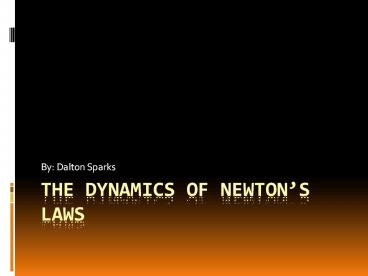The Dynamics of Newton's Laws By: D Sparks - PowerPoint PPT Presentation
Title:
The Dynamics of Newton's Laws By: D Sparks
Description:
A brief summary of Newton's Laws – PowerPoint PPT presentation
Number of Views:259
Title: The Dynamics of Newton's Laws By: D Sparks
1
The Dynamics of Newtons Laws
- By Dalton Sparks
2
Magnetic Force
- Magnetic forces are produced by moving electrical
charges. - Magnetic and electric forces are very closely
related
3
Electric Forces
- The force that appears when you push something is
electric force. - This type of force develops as electrons of the
hand is brought close to the electrons of an
object.
4
Gravitational Force
- This type of force is extremely weak compared to
the other forces. - This force happens when things fall.
5
Weak interaction and nuclear
- Nuclear force is much stronger than any other
force. - This force holds together the nucleus of an atom
together. - Scientists believe that a second force exists in
the nuclei of an atom. Weak interaction is
believed to be the force that breaks atoms a part.
6
Newtons first law.
- Newtons first law of motion states that an
object in motion will stay in motion and an
object at rest will stay at rest unless an
outside force is acted upon it. - If you were to throw a ball the ball would keep
going until friction in the air stops it and
gravity pulls it down.
7
Newtons second law
- Newtons second law states that when an
unbalanced force acts upon a body the body will
accelerated. - For example if you were to hit a ball the ball
would go in the direction that the objects force
is going.
8
Newtons third law
- Newtons third law states that for every action
there is an equal and opposite reaction. - For example when you shoot a gun the gun will
shoot but also kick back because its a form of
recoil.
9
FMA
- This formula means that force is equal to mass
multiplied by acceleration. - That means that if a car has a mass of 1,000 N
and it is accelerating by 20N its force would be
20,000.
10
MF/A
- This formula means that mass is equal to the
force of an object divided by its acceleration. - An example of this is if a car has a force of
2000N and an acceleration of 40N its mass would
be 500.
11
AF/m
- This means that an objects acceleration can be
found by dividing its force by its mass. - For example if a car has a force of 100N and a
mass of 10N its acceleration would be 10N.
12
WMG
- This formula states that an objects weight can
be found by dividing its mass by its
gravitational pull. - For example if a car has a mass of 100 N and a
gravitational pull of 10N then its weight would
be 10N.
13
Mw/G
- This means that an objects mass is equal to the
weight of an object divided by its gravitational
pull. - For example if a car weighs 100N and has a
gravitational pull of 5 N its mass is 20N.
14
GW/M
- This formula means that an objects gravitational
pull is equal to its weight divided by its mass. - For example if a car has a weight of 100N and a
mass of 10N its gravitational pull is 10N































